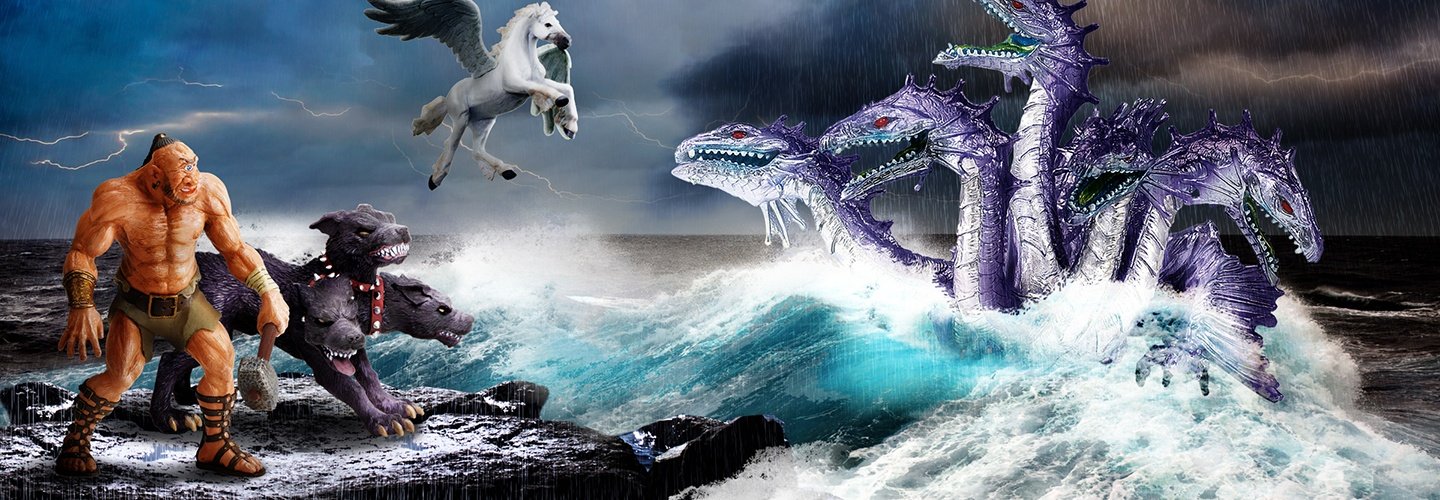Greek mythology was a way for the people of ancient Greece to explain the nature of the world around them, by ascribing various phenomena and events to gods and other fantastical beings. We know about these myths from literary works by ancient Greek poets, and from art painted on vases and wall frescoes that were discovered at archaeological sites. Greek mythology remains a popular topic, due in large part to the fascinating characters and creatures that populate these fables.
Many Greek myths feature sinister monsters that must be overcome by a hero. These monsters are sometimes human-like in nature, with strange characteristics that set them apart from people. They may also represent combinations of various animals into a single creature. And sometimes, they combine human and animal features to create a completely new being altogether.
What Monsters Did Hercules Fight?
Often, a Greek hero on an epic journey encounters at least one of these monsters. Sometimes, they’re unlucky enough to encounter several. Hercules, also known as Heracles, is probably the most well-known Greek hero of them all. During his 12-year service to King Eurystheus, he was tasked with 12 labors to carry out for the king. The second of these involved slaying the Lernaean Hydra, a wicked reptilian creature with numerous tooth-filled heads. Every time one head was cut off, two more would grow in its place! Hercules managed to slay the beast by burning the creature’s necks so the heads could not regrow.
The final labor Hercules was given was to retrieve the beast known as Cerberus from the underworld, which was ruled by the god Hades. Eurystheus specifically gave Hercules this task because he did not believe it was possible. Cerberus was a fearsome three-headed dog whose job was to guard the entrance to the underworld. Not only did Hercules manage to retrieve the beast with some help from the gods Hermes and Athena, he also rescued the hero Theseus, who had been held prisoner by Hades.
What Was the Minotaur?
Speaking of Theseus, he is well-known for his own encounter with a monstrous mythical creature. Theseus famously slew the Minotaur, a half-man, half-bull monster that lived in the Labyrinth of Crete. The Labyrinth was a huge maze with the Minotaur at the center, and Theseus used his father Aegus’s sword to defeat the best. He escaped the labyrinth by following a thread he’d left behind him, allowing him to retrace his path.
Who Was Medusa?
Yet another famous hero of ancient Greece was Perseus, who fought the Gorgon Medusa. Medusa was a female monster with snakes for hair who turned anyone who looked upon her to stone. Perseus managed to slay her by only looking at her reflection in a polished shield when approaching her, and then using his sword to cut off her head. Her head could still turn people to stone, so it needed to be kept in a special satchel. Perseus would later use it to slay the mighty sea monster Cetus, in order to save a woman named Andromeda, who would become Perseus’s wife.
When Perseus killed Medusa, from her blood sprang the winged horse Pegasus. Not all Greek monsters are evil, and Pegasus would eventually become one of the steeds of Zeus, ruler of the gods. Pegasus was a beautiful horse with pure white fur and wings, and every time he set a foot on the ground, a spring of water would burst forth from the ground. Pegasus helped the hero Bellerophon in his fight against the Chimera, a monster that was part lion, part goat, and part snake.
What Monsters Did Odysseus Fight?
Most of the heroes of ancient Greek myth undertake a journey, but no journey was more epic than that of Odysseus, who struggled to get home after the Trojan War. The word “odyssey” is often used to describe a long and difficult journey, and it gets its name from Odysseus. On his way home, Odysseus would encounter many monsters, including the one-eyed giant called the Cyclops and the sea monster known as Scylla. Though Odysseus himself escaped these creatures and eventually made his way back home, many of his companions were not so lucky.
Heroes are often only as interesting as the villains they face, and Greek mythology is full of malicious monsters to keep heroes on their toes. For more mythical beasts, check out safariltd.com!
Want more Greek Mythology fun? Check out the FAVORITE MYTHS - GREEK MYTHS Tonies Audio Play Character
Bernie’s Bonus Fun Fact: One of the greatest teachers of heroes in Greek mythology was Chiron, who tutored both Hercules and Perseus, as well as Achilles, the hero of the Trojan War. Chiron was a centaur, which was a creature whose upper half resembled a human, while the lower half was that of a horse.



